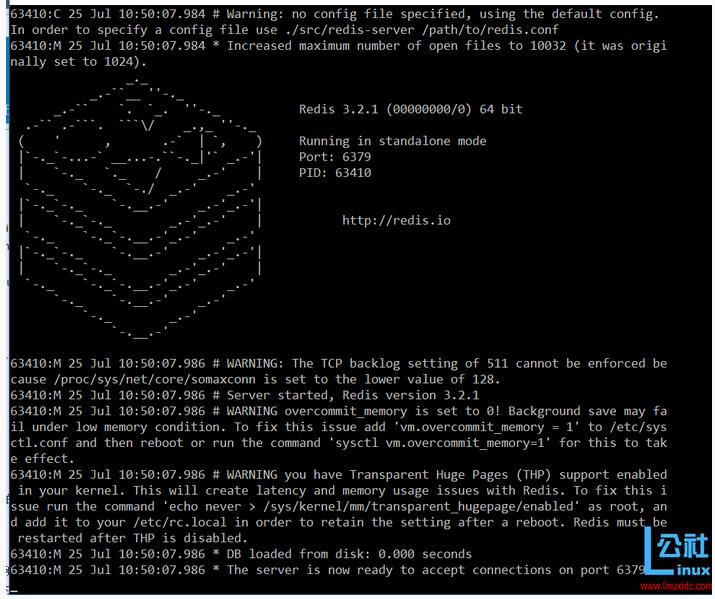CentOS 7.0 安装Redis 3.2.1详细过程和使用常见问题
Posted
tags:
篇首语:本文由小常识网(cha138.com)小编为大家整理,主要介绍了CentOS 7.0 安装Redis 3.2.1详细过程和使用常见问题相关的知识,希望对你有一定的参考价值。
http://www.linuxidc.com/Linux/2016-09/135071.htm
环境:CentOS 7.0 Redis 3.2.1
Redis的安装与启动
这里我把Redis放在/home/linuxidc/software/下,所以在该目录下执行下列命令:
$ wget http://download.redis.io/releases/redis-3.2.1.tar.gz
$ tar xzf redis-3.2.1.tar.gz
$ cd redis-3.2.1
$ make至此Redis已经安装完成,首先试一下能不能把启动:
启动命令(在/home/linuxidc/software/redis-3.2.1目录下执行):
[root@localhost redis-3.2.1]# ./src/redis-server ../redis.conf
如下:

常见问题及解决方法
根据上图中的警告信息,下边是具体的解决方法
1、启动的时候没有设置配置文件
这个版本的时候需要指定,如果不指定的话,在后期修改了配置文件不会起到对应的效果
11292:C 25 Jul 13:13:58.034 # Warning: no config file specified, using the default config. In order to specify a config file use ./redis-server /path/to/redis.conf这个说的是在启动的时候要制定配置文件,如果没有指定的话就会按照默认的配置,因此我们要制定具体的位置,具体命令为:
[root@localhost src]# ./redis-server ../redis.conf
2、启动时报错及解决方法
1、WARNING overcommit_memory is set to 0! Background save may fail under low memory condition. To fix this issue add \'vm.overcommit_memory = 1\' to /etc/sysctl.conf and then reboot or run the command \'sysctl vm.overcommit_memory=1\' for this to take effect.
2、WARNING: The TCP backlog setting of 511 cannot be enforced because /proc/sys/net/core/somaxconn is set to the lower value of 128.解决方法其实按照上边的说明就可以解决
第一个警告两个方式解决(overcommit_memory)
echo "vm.overcommit_memory=1" > /etc/sysctl.conf 或 vi /etcsysctl.conf然后reboot重启机器,重启之后执行下边的内容
echo 1 > /proc/sys/vm/overcommit_memory 不需要启机器就生效第二个警告解决
echo 511 > /proc/sys/net/core/somaxconn其实在报错信息的时候已经给出了解决的方法,按照给定的具体的方法解决即可。
3、在上述 2 中的解决方法的一些参数说明
(1)overcommit_memory参数说明:
设置内存分配策略(可选,根据服务器的实际情况进行设置)
/proc/sys/vm/overcommit_memory
可选值:0、1、2。
0, 表示内核将检查是否有足够的可用内存供应用进程使用;如果有足够的可用内存,内存申请允许;否则,内存申请失败,并把错误返回给应用进程。
1, 表示内核允许分配所有的物理内存,而不管当前的内存状态如何。
2, 表示内核允许分配超过所有物理内存和交换空间总和的内存注意:redis在dump数据的时候,会fork出一个子进程,理论上child进程所占用的内存和parent是一样的,比如parent占用 的内存为8G,这个时候也要同样分配8G的内存给child,如果内存无法负担,往往会造成redis服务器的down机或者IO负载过高,效率下降。所 以这里比较优化的内存分配策略应该设置为 1(表示内核允许分配所有的物理内存,而不管当前的内存状态如何)。
(2)这里又涉及到Overcommit和OOM。
什么是Overcommit和OOM,在Unix中,当一个用户进程使用malloc()函数申请内存时,假如返回值是NULL,则这个进程知道当前没有可用内存空间,就会做相应的处理工作。许多进程会打印错误信息并退出。
Linux使用另外一种处理方式,它对大部分申请内存的请求都回复”yes”,以便能跑更多更大的程序。因为申请内存后,并不会马上使用内存。这种技术叫做Overcommit。
当内存不足时,会发生OOM killer(OOM=out-of-memory)。它会选择杀死一些进程(用户态进程,不是内核线程),以便释放内存。
(3)Overcommit的策略
Linux下overcommit有三种策略(Documentation/vm/overcommit-accounting):
- 启发式策略。合理的overcommit会被接受,不合理的overcommit会被拒绝。
- 任何overcommit都会被接受。
- 当系统分配的内存超过swap+N%*物理RAM(N%由vm.overcommit_ratio决定)时,会拒绝commit。
overcommit的策略通过vm.overcommit_memory设置。
overcommit的百分比由vm.overcommit_ratio设置。
echo 2 > /proc/sys/vm/overcommit_memory
echo 80 > /proc/sys/vm/overcommit_ratio当oom-killer发生时,linux会选择杀死哪些进程选择进程的函数是oom_badness函数(在mm/oom_kill.c中),该函数会计算每个进程的点数(0~1000)。点数越高,这个进程越有可能被杀死。每个进程的点数跟oom_score_adj有关,而且oom_score_adj可以被设置(-1000最低,1000最高)。
设置Redis外网可访问
值得注意的是在3.2.0以后的新版本中引入了一种proteced mode 模式,详见:http://redis.io/topics/security
在不修改配置文件任何内容的情况下,有以下几个默认的配置:
# By default, if no "bind" configuration directive is specified, Redis listens
# for connections from all the network interfaces available on the server.
# It is possible to listen to just one or multiple selected interfaces using
# the "bind" configuration directive, followed by one or more IP addresses.
#
# Examples:
#
# bind 192.168.1.100 10.0.0.1
# bind 127.0.0.1 ::1
#
# ~~~ WARNING ~~~ If the computer running Redis is directly exposed to the
# internet, binding to all the interfaces is dangerous and will expose the
# instance to everybody on the internet. So by default we uncomment the
# following bind directive, that will force Redis to listen only into
# the IPv4 lookback interface address (this means Redis will be able to
# accept connections only from clients running into the same computer it
# is running).
#
# IF YOU ARE SURE YOU WANT YOUR INSTANCE TO LISTEN TO ALL THE INTERFACES
# JUST COMMENT THE FOLLOWING LINE.
# ~~~~~~~~~~~~~~~~~~~~~~~~~~~~~~~~~~~~~~~~~~~~~~~~~~~~~~~~~~~~~~~~~~~~~~~~
bind 127.0.0.1
# By default protected mode is enabled. You should disable it only if
# you are sure you want clients from other hosts to connect to Redis
# even if no authentication is configured, nor a specific set of interfaces
# are explicitly listed using the "bind" directive.
protected-mode yes
# Require clients to issue AUTH <PASSWORD> before processing any other
# commands. This might be useful in environments in which you do not trust
# others with access to the host running redis-server.
#
# This should stay commented out for backward compatibility and because most
# people do not need auth (e.g. they run their own servers).
#
# Warning: since Redis is pretty fast an outside user can try up to
# 150k passwords per second against a good box. This means that you should
# use a very strong password otherwise it will be very easy to break.
#
# requirepass foobared
简单的就是:
bind 127.0.0.1
protected-mode yes
# requirepass foobared默认绑定的是127.0.01,默认开启了:protected-mode模式,按照官方的说法,如果默认开启了protected-mode模式在没有配置绑定IP和密码的情况下,是只允许回环地址进行访问的,就只允许127.0.0.1进行访问,那我们就在默认的配置下进行启动,通过SSH工具在其他机器上进行访问,看看运行的效果:
[root@localhost redis-3.2.1]# ./src/redis-server ../redis.conf
以上是关于CentOS 7.0 安装Redis 3.2.1详细过程和使用常见问题的主要内容,如果未能解决你的问题,请参考以下文章